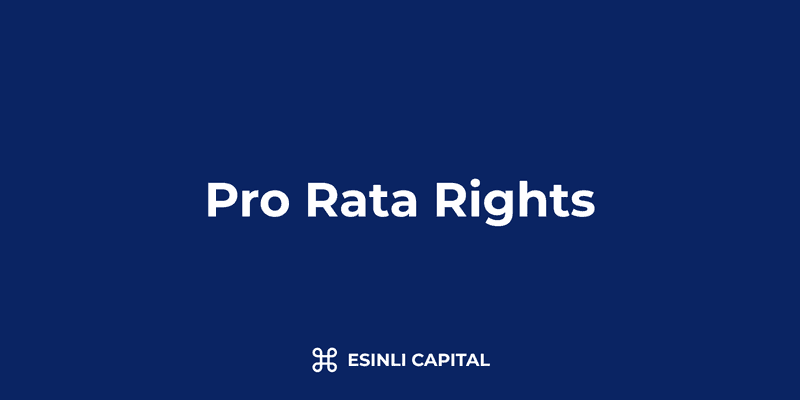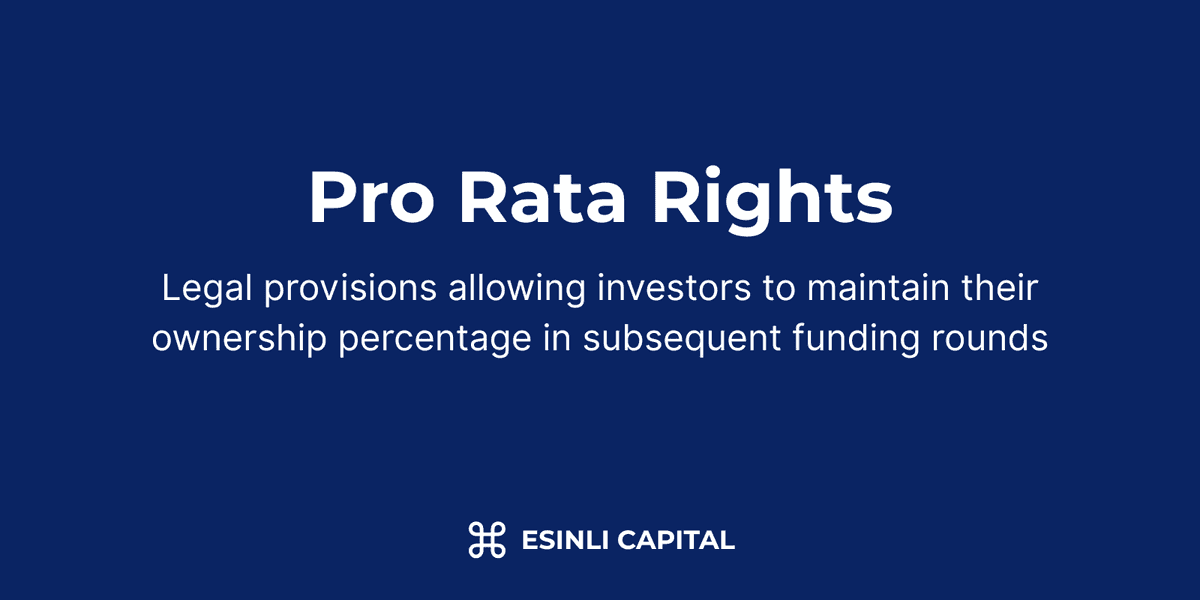In This Article
- What Are Pro Rata Rights?
- Why Are Pro Rata Rights Important for Investors?
- Pro Rata Rights from a Founder's Perspective
- Pro Rata Rights vs. Right of First Refusal
- Implementation and Management of Pro Rata Rights
- Pro Rata Rights in Different Investment Stages
- Expert Strategies for Pro Rata Negotiations
- Common Mistakes and How to Avoid Them
- Pro Rata Rights: What Will Maximize Your Strategy?
- FAQs
- The Bottom Line
- What Are Pro Rata Rights?
- Why Are Pro Rata Rights Important for Investors?
- Pro Rata Rights from a Founder's Perspective
- Pro Rata Rights vs. Right of First Refusal
- Implementation and Management of Pro Rata Rights
- Pro Rata Rights in Different Investment Stages
- Expert Strategies for Pro Rata Negotiations
- Common Mistakes and How to Avoid Them
- Pro Rata Rights: What Will Maximize Your Strategy?
- FAQs
- The Bottom Line

Pro Rata Rights: Definition, Value & Implementation
KEY TAKEAWAYS
- Pro rata rights give investors the option (not obligation) to participate in future financing rounds to maintain their ownership percentage
- These rights help protect investors from ownership dilution when new shares are issued during subsequent fundraising
- Pro rata provisions are standard in venture capital term sheets and are particularly valued by early-stage investors
- Strategic use of pro rata rights can significantly impact a startup's cap table management and long-term investor relationships
- Founders should carefully negotiate pro rata terms to balance investor protection with flexibility for future fundraising
What Are Pro Rata Rights?
Pro rata rights (also called participation rights or pre-emptive rights) are provisions in investment agreements that give existing investors the right—but not the obligation—to participate in future financing rounds to maintain their ownership percentage in a company. The term "pro rata" comes from Latin, meaning "in proportion," which perfectly describes the mechanism: investors can invest proportionally to their current stake.
For example, if an investor owns 10% of a company before a new financing round, pro rata rights allow them to purchase enough new shares to maintain that 10% ownership after the round closes, preventing dilution of their stake.
How Pro Rata Rights Work
When a startup raises a new round of funding, it typically issues new shares, which dilutes the ownership percentage of existing shareholders. Pro rata rights counteract this dilution by giving existing investors the opportunity to purchase a portion of the new shares.
The formula for calculating pro rata allocation is straightforward:
Pro Rata Allocation = (Investor's Current Ownership %) × (Total New Shares Issued)
For instance, if an investor owns 5% of a company that's issuing 1,000,000 new shares, their pro rata right would entitle them to purchase up to 50,000 shares (5% of the new issuance).
Types of Pro Rata Provisions
Pro rata rights can vary in their specifics:
- Standard Pro Rata Rights: Allow investors to maintain their exact percentage ownership
- Super Pro Rata Rights: Give investors the right to increase their percentage ownership in future rounds
- Qualified Pro Rata Rights: Apply only under certain conditions or to specific financing rounds
- Tiered Pro Rata Rights: Provide different participation levels based on investor class or ownership threshold
Why Are Pro Rata Rights Important for Investors?
Pro rata rights are among the most valued provisions for investors, particularly in early-stage investments where the potential for significant dilution exists across multiple funding rounds.
Protection Against Dilution
The primary value of pro rata rights is dilution protection. Without these rights, an investor who owns 10% of a company could see their stake reduced to 7% or less after a new funding round, even if the company's valuation increases. Pro rata rights give investors the option to prevent this erosion of ownership.
Doubling Down on Winners
Experienced investors know that returns in venture capital often follow a power law distribution—a small percentage of investments generate the majority of returns. Pro rata rights allow investors to "double down" on their successful investments by maintaining or increasing their stake in companies that are performing well.
As Fred Wilson of Union Square Ventures noted, "The ability to follow your winners is a key part of generating strong returns in early-stage investing."
Signaling and Information Rights
The decision of whether existing investors exercise their pro rata rights sends powerful signals to the market. When prominent investors choose to maintain or increase their positions, it can positively influence new investors' perception of the company.
Additionally, the negotiation process around pro rata rights often provides investors with valuable information about the company's performance and future plans before the general market has access to this information.
Pro Rata Rights from a Founder's Perspective
For startup founders, pro rata rights represent an important consideration in fundraising strategy and cap table management.
Balancing Investor Interests and Company Flexibility
While pro rata rights benefit investors, they can potentially constrain a company's flexibility in future financing rounds. If too many existing investors have strong pro rata rights and exercise them fully, there may be insufficient room for new investors to take meaningful positions in the company.
Founders must balance honoring commitments to early supporters while creating space for new strategic investors who can add value beyond capital.
Negotiation Strategies for Founders
When negotiating pro rata provisions, founders should consider:
- Ownership Thresholds: Setting minimum ownership requirements for pro rata rights to remain valid (e.g., investors must maintain at least 1% ownership)
- Time Limitations: Limiting pro rata rights to specific rounds or time periods
- Major Investor Definitions: Restricting full pro rata rights to "major investors" who meet certain investment thresholds
- Pay-to-Play Provisions: Requiring investors to participate in certain financing rounds to maintain their pro rata rights
As Y Combinator advises founders: "Pro rata rights are reasonable for investors who add value, but consider qualifying these rights to maintain future flexibility."
Pro Rata Rights vs. Right of First Refusal
Pro rata rights are often confused with the right of first refusal (ROFR), but they serve different purposes:
| Pro Rata Rights | Right of First Refusal |
|---|---|
| Apply to new shares issued by the company | Apply to existing shares being sold by shareholders |
| Allow maintaining percentage ownership | Allow purchasing shares before they're offered to outside parties |
| Activated during new financing rounds | Activated when existing shareholders want to sell |
While distinct, both mechanisms help protect investor interests and are commonly included in venture financing documents.
Implementation and Management of Pro Rata Rights
Implementing pro rata rights requires careful attention to legal documentation and process management.
Documentation in Term Sheets and Financing Agreements
Pro rata rights are typically documented in:
- Term sheets
- Stock purchase agreements
- Investors' rights agreements
- Certificate of incorporation
The specific language should clearly outline:
- Who holds the rights (all investors or only those meeting certain criteria)
- The process for exercising the rights
- Any limitations or qualifications on the rights
- How the rights are affected by different types of financings (equity vs. convertible instruments)
Process for Exercising Pro Rata Rights
The typical process follows these steps:
- Notification: The company notifies eligible investors of an upcoming financing round
- Information Disclosure: Investors receive term sheets and relevant company information
- Election Period: Investors have a defined period (typically 10-20 days) to indicate whether they'll exercise their rights
- Allocation Calculations: The company calculates each investor's pro rata allocation based on current ownership
- Documentation and Closing: Participating investors complete the necessary paperwork and fund their investments
Edge Cases and Special Considerations
Several scenarios require special handling of pro rata rights:
- Convertible Notes and SAFEs: How pro rata rights apply when earlier investments haven't yet converted to equity
- Secondary Transactions: Whether pro rata rights are triggered by secondary sales
- Strategic Investments: How to handle situations where strategic investors require larger allocations
- Oversubscribed Rounds: Managing pro rata allocations when rounds are oversubscribed
Pro Rata Rights in Different Investment Stages
The importance and implementation of pro rata rights can vary significantly across investment stages.
Seed and Angel Rounds
In early rounds, pro rata rights are particularly valuable to investors who are taking outsized risk. However, the documentation may be simpler, sometimes included in side letters rather than extensive legal agreements.
For seed investors, securing strong pro rata rights can be critical to their investment strategy, as it allows them to maintain meaningful ownership as the company grows and raises larger rounds.
Series A and Beyond
As companies progress to institutional rounds, pro rata provisions become more standardized but also more complex. By Series B and beyond, the exercise of pro rata rights becomes a significant strategic decision for both the company and its investors.
Companies at later stages may begin to qualify or limit pro rata rights to create room for new strategic investors while respecting the rights of early supporters.
Expert Strategies for Pro Rata Negotiations
Both investors and founders can employ strategic approaches to pro rata negotiations.
For Investors
- Focus on Qualifying Rounds: Ensure pro rata rights apply to all equity financing rounds, including convertible note conversions
- Consider Information Requirements: Link pro rata rights to robust information rights to make informed follow-on decisions
- Clarify Application to Secondary Transactions: Negotiate whether rights apply to secondary sales or only primary issuances
- Address Transfer Provisions: Determine whether pro rata rights can be transferred if you sell your shares
For Founders
- Create Major Investor Thresholds: Limit full pro rata rights to investors meeting minimum investment amounts
- Implement Use-It-or-Lose-It Provisions: Consider provisions where rights expire if not exercised in specific rounds
- Reserve Strategic Allocation: Negotiate carve-outs for strategic investors even when pro rata rights would otherwise fill a round
- Manage Allocation Timing: Structure notification and election periods to optimize round management
Common Mistakes and How to Avoid Them
Investor Mistakes
- Neglecting to Secure Rights: Failing to negotiate pro rata rights in initial investments
- Lack of Follow-On Capital: Securing rights but not reserving capital to exercise them
- Missing Notification Deadlines: Failing to respond within required timeframes
- Overestimating Future Capacity: Assuming future fund capacity will allow participation in later, larger rounds
Founder Mistakes
- Granting Uncapped Rights: Giving unlimited pro rata rights to too many investors
- Ignoring Downstream Implications: Not considering how early pro rata promises will affect later rounds
- Inadequate Documentation: Failing to properly document and track pro rata entitlements
- Poor Communication: Not maintaining clear communication with investors about upcoming opportunities to exercise rights
Pro Rata Rights: What Will Maximize Your Strategy?
Whether you're an investor seeking to protect your ownership or a founder trying to build a balanced cap table, understanding and strategically approaching pro rata rights is essential for long-term success in the startup ecosystem.
The most effective approaches typically blend flexibility with commitment:
- For Investors: Secure meaningful rights but be selective about when to exercise them, focusing on your highest-conviction investments
- For Founders: Respect the importance of pro rata rights to early supporters while maintaining sufficient flexibility to bring in valuable new investors
Ultimately, pro rata rights represent a balancing act between protecting existing stakeholders and creating room for company growth—when handled thoughtfully, they can align incentives and strengthen the investor-founder relationship across multiple funding rounds.
FAQs
Are pro rata rights legally required?
No, pro rata rights are not legally mandated but are standard provisions negotiated in private investment agreements. Public companies in some jurisdictions may have statutory pre-emptive rights for shareholders, but private companies typically address these rights through contractual provisions.
Can pro rata rights be transferred?
It depends on the specific language in the investment agreement. Some agreements allow pro rata rights to be transferred along with the underlying shares, while others specify that these rights are personal to the original investor and cannot be transferred.
Do pro rata rights apply to all types of financing?
The application of pro rata rights to different financing instruments should be explicitly defined in the investment agreement. Standard pro rata provisions typically apply to equity financing rounds, but may or may not apply to convertible instruments, debt financing, or certain types of strategic investments.
How do pro rata rights affect company valuation?
Pro rata rights themselves typically don't directly impact valuation, but the exercise of these rights can influence round dynamics. When strong existing investors exercise their pro rata rights, it can signal confidence to new investors and potentially support higher valuations.
Can pro rata rights expire?
Yes, pro rata rights often include expiration provisions. These may be time-based (expiring after a certain number of years), event-based (expiring after specific financing rounds), or threshold-based (expiring if an investor's ownership falls below a specified percentage).
The Bottom Line
Pro rata rights are fundamental to the venture capital ecosystem, providing investors with protection against dilution while giving them the option to continue supporting their most promising portfolio companies. For founders, thoughtfully structured pro rata provisions balance respect for early investors with the flexibility needed to build a diverse and strategic cap table over multiple funding rounds.
As with many aspects of startup financing, the details matter significantly. Both investors and founders should work with experienced counsel to ensure pro rata provisions align with their strategic objectives and set the foundation for productive long-term partnerships.



